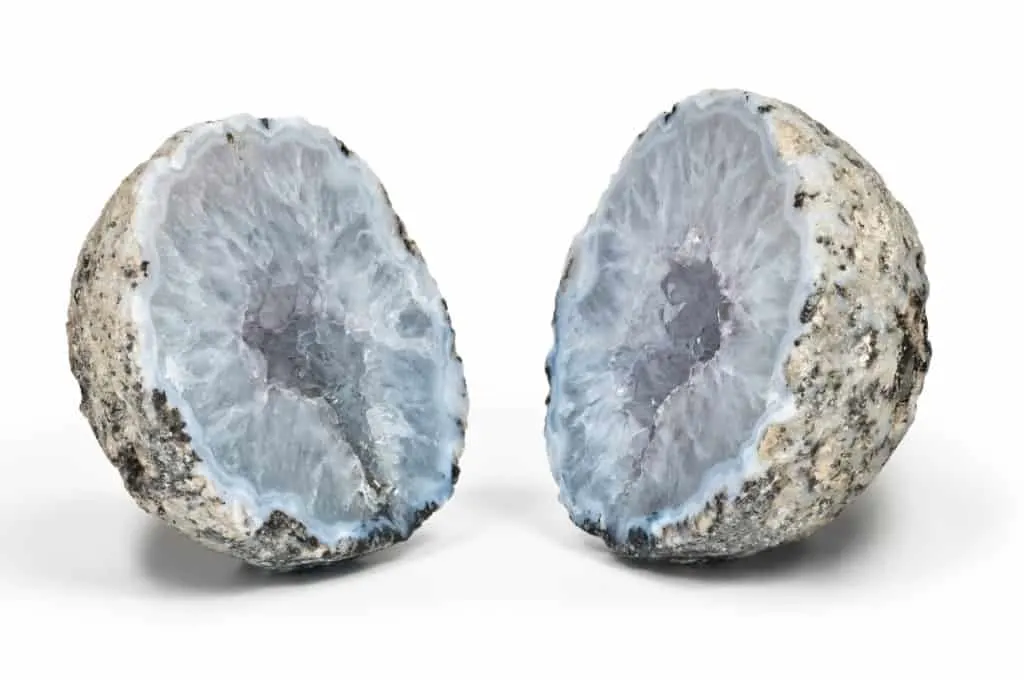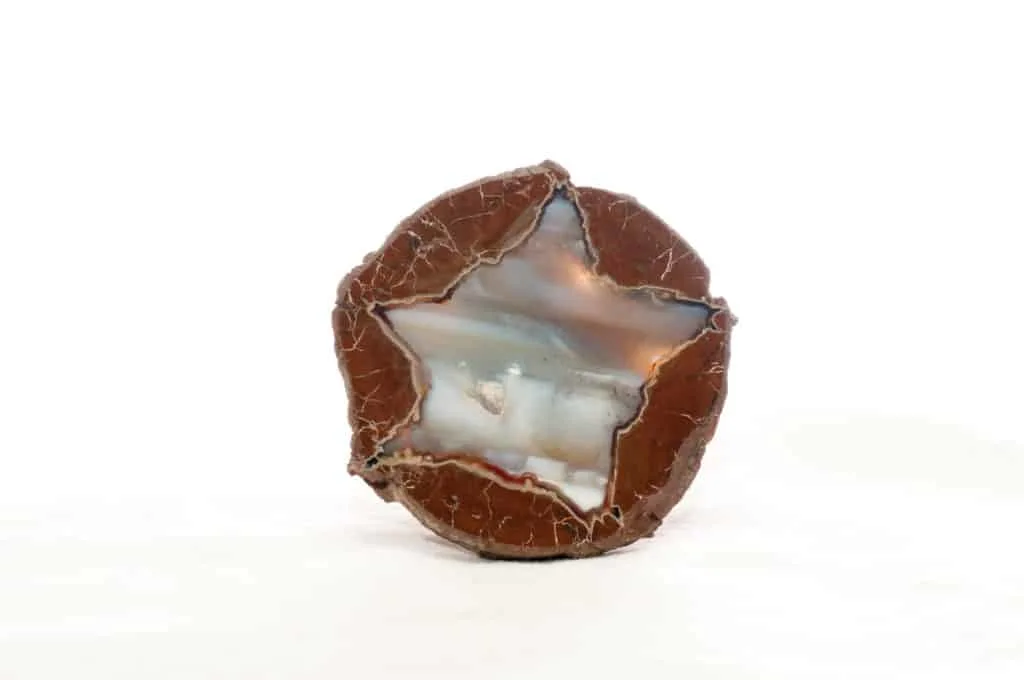As an Amazon Associate, I earn from qualifying purchases with no additional costs for you.
Geodes and thundereggs are true miracles in the geology world. They are highly praised because of their intriguing appearance and formation history. Both geodes and thundereggs look like ordinary stones from the outside. At the same time, they hide a magnificent world of minerals of various forms inside.
The main difference between a geode and a thunderegg is that a geode is composed of crystals with a hollow inside, while a thunderegg is solid. Thunderegg has defined rock and mineral composition. Thundereggs are chalcedony consolidations in rhyolite rocks, while geodes can contain various types of crystals.
Geodes and thundereggs may appear similar at the first glance. That’s why a lot of misunderstanding occurs in their differentiation. We will provide you with complete disclosure of how to separate them easily.

If you are interested in checking out the best book about geodes and their identification you can find it by clicking here (Amazon link).
What’s the Difference Between a Geode and a Thunderegg?
Geodes and thundereggs differences are mostly related to their rock and mineral composition and their formation process.
Thundereggs are a geologic structure that forms specifically in rhyolites lined with chalcedony or agate and are mostly solid, while geodes are geological formations without any strict mineral composition with a hollow inside. The main difference is that thundereggs are mostly solid, but geodes are hollow.
Here are some tips for you to distinguish between thundereggs and geodes.
- Thunder eggs are completely solid inside (of course, there are some exceptions, but the next steps will allow understanding them).
- Thunder eggs are red, light-pink, pinkish-red, reddish-brown, and brown from the outside because of the color of rhyolites.
- Thunder eggs are not perfectly round from the inside. Chalcedony or agate can form star-like figures.
- Geodes can be black, gray, white, creamy, or yellowish from the outside
- Geodes are hollow inside.
- Geodes have well-faceted crystals, which grow towards the center of the hollow.
- Thundereggs can be formed in volcanic rhyolite rocks, while geodes can be formed both in volcanic rocks (andesite or basalts) or sedimentary rocks.
A comparison between thunderegg and geode:
| Characteristic | Thunderegg | Geode |
|---|---|---|
| Outer shell color | The color of rhyolites: pale-colored, often light grey, tan, pinkish, red, reddish-brown. | Any color. From white, yellowish-white, and orange to gray and black. |
| Genesis | Volcanic. | Can be both volcanic and sedimentary. |
| Mineral composition | Microcrystalline varieties of quartz (chalcedony, agate, jasper). | Rock quartz, amethyst, ametrine, celestine, calcite, hematite, magnetite, pyrite, millerite, barite, etc. |
| Crystal presence | Materials are cryptocrystalline. No crystals were observed. | Well-formed faceted crystals. |
| Presence of the hollow inside | Mostly solid. | Hollow. |
TIP: Do you know how valuable can geodes be? You will know the real value of the geode when you open it. Find out how valuable geodes can be in the article below:
The Value of Geodes: Are They Worth Anything?
How to Identify Geodes?

Geode is a spherical geological formation, with a hollow inside. The inner part of the geode reveals perfectly formed crystals of rock quartz, amethyst, calcite, or celestine growing towards the center of the hollow. Sometimes geodes can be lined with banded agates of various colors.
The appearance of geodes is defined by their way of formation. There are two types of geode formation processes.
- The first one is volcanic, where voids are formed during magma uplift from beneath the earth to the surface. Some bubbles solidify inside the lava flow providing a space for crystal growth.
- The second way of geode formation is sedimentary. In such cases cavities for further geode formation are left after fossil shells, branches, roots, and other organic materials decay.
Groundwater or low-temperature hydrothermal solutions precipitate in voids forming crystals growing towards the center of the void.
The most common crystals found inside a geode are quartz and its purple variety amethyst. Less common are calcite, aragonite, celestine. Rare crystals of hematite, magnetite, pyrite, millerite, baryte, and rhodochrosite can be also found and are highly praised by professional mineral collectors.
Recommendation: Are you interested in opening geodes? National Geographic offers an amazing geodes opening kit, including 10 premium geodes, goggles, a detailed learning guide, and 2 display stands. You can check the price by clicking here (Amazon link).
TIP: Rock cutting is a specialized task, and you cannot use any old saw for the job. Rock-cutting saws require high RPMs and power to cut through the tough material. Find out more in the article below:
What Is The Best Saw For Cutting Rocks? Try These 3 Saws
How to Identify Thundereggs?

Thundereggs (or what is called lithophysae in geology) are unique geological structures of spherical appearance, which form specifically in rhyolites (silica-rich volcanic rock) and are partly or fully lined by microcrystalline varieties of quartz (chalcedony, agate, jasper, or opal).
Thundereggs formation conditions are very specific. A very precise rock composition should be met for the formation to be considered a thunderegg. A thunderegg is a geologic structure that forms specifically in rhyolites.
Rhyolites are light-colored commonly reddish volcanic rocks with high silica (SiO2) content of 70 percent or more. This extrusive rock is commonly associated with big, violent, volcanic explosions.
Rhyolites can contain a lot of pores (former gas bubbles), which solidified before gas escaped from molten lava. These voids provide a space for further thundereggs formation.
Groundwater or low-temperature hydrothermal solutions transport silica in a dissolved state to the voids and deposit them into the cavities. The fluids contain some elements from the original magma and also dissolved minerals from the country rock (which are enriched in silica as we have already discussed).
This highly concentrated water solution gradually turns into silica gel. It eventually hardens into chalcedony, agate, quartz, or a combination of these minerals.
In contrast to geodes, which can contain various minerals inside, the thundereggs core is represented exceptionally by amorphous silica minerals. Silica composition is explained by the composition of country rock, which has high silica content (up to 70 %).
The amorphous or cryptocrystalline state of the inner thunder egg’s minerals can be explained by the rapid cooling of a silica-saturated fluid.
Faceted quartz crystals indicate that the fluids were somewhat supersaturated with silica and that precipitation occurred under relatively slow-changing conditions.
TIP: Thundereggs are truly a mysterious beast. When you find thunderegg you want to see what is inside. But do you know to do it correctly? Check out the step-by-step guide on how to cut and polish thundereggs in the article below:
How to Cut & Polish Thundereggs: Follow These 6 Simple Steps
FAQ: Geode vs. Thunderegg
Still did not find the answer to your answers about the differences between geode and thunderegg. Find frequently asked questions in the section below:
Is thunder egg a geode?
Thunderegg can be considered a geode if it is composed of solidified rhyolite lava outermost layer, filled with chalcedony or other microcrystalline quartz (agate, opal), and has a hollow inside. A solid thunder egg without any hollow is better to call a thunder egg exceptionally.
Why are geodes called thunder eggs?
No mistakes here. Some geodes can be called thunder eggs if they are made of solidified rhyolites outer shell, linen by chalcedony, and have a void inside. Please, pay attention here! These two terms are not synonyms. Thunderegg can be called a geode, but not all geodes are thunder eggs.
Are all thunder eggs solid?
In most cases, yes. The core of the thunder egg is completely filled with chalcedony. But, of course, you can run into some exceptions.
If you see a reddish rhyolites outer core and chalcedony, but the center has a small hollow lined with tiny quartz crystals, it’s still a thunder egg. Despite the hollow inside, while it is made of rhyolites and chalcedony, it is a thunder egg.
What is inside a thunder egg?
Because of the specific silica-rich conditions of thunder egg formation, it is filled with chalcedony, agate, jasper, or opal. These minerals are microcrystalline and amorphous varieties of quartz.
There are no big crystals inside thunder eggs, unlike geodes, because of the different times of silica-rich solution cooling. The solution is believed to cool faster in thunder eggs, which do not provide enough time for big crystals to grow.
BTW: Do you want to know more about rock and mineral identification? The books listed below are the best ones you can find on the internet (Amazon links):
- Smithsonian Handbooks: Rocks & Minerals
- Gemstone & Crystal Properties (Quick Study Home)
- Ultimate Explorer Field Guide: Rocks and Minerals (National Geographic Kids)
Conclusion
Thundereggs and geodes are the crowns of any mineral collection. They demonstrate how intriguing rock-forming processes can be. Because of their ordinary earthy appearance from the outside and a real mineral treasure inside, misunderstanding in terms occur.
To define it once and for all here are the main thesis for you:
- Thunderegg has a very specific rock and mineral composition as a result of its volcanic formation. Geode is a broader term with no such restrictions.
- Thunder eggs are formed in the volcanic flow of rhyolites, while geodes can be formed both in volcanic and sedimentary rocks.
- The difference in the formation environments results in different colors of thunder egg versus geode outer shell. Thunder eggs are usually light-red, pink, and reddish-brown, while geodes’ outer shell color can vary from white to vibrant black.
- Thunder eggs are filled with microcrystalline quartz or amorphous silica only, which can be chalcedony, agate, jasper, or even opal). Geodes can have different types of minerals inside (amethyst, celestine, calcite, hematite, magnetite, pyrite, millerite, baryte, etc.).
- Thunder eggs are solid in most cases, while geodes usually have a hollow inside.
- Most geodes contain well-formed faceted crystals, while the material inside a thunder egg is usually cryptocrystalline and no crystals can be defined.
- Thunderegg’s inner part can be sometimes star-like, while most geodes’ inner core is usually round.
TIP: Do you know what are the most common types of crystals you can find in geodes? I bet you will be surprised in some cases. Find out more in the article below:
16 Most Common Types of Crystals You Can Find in Geodes
